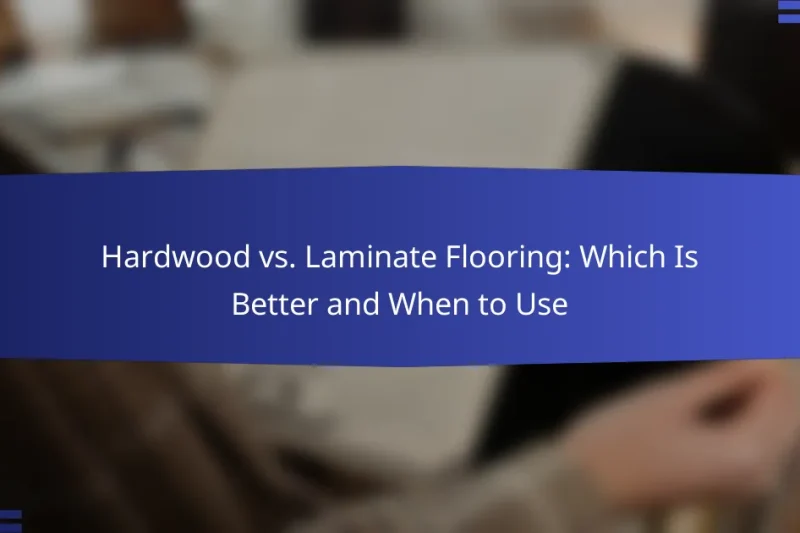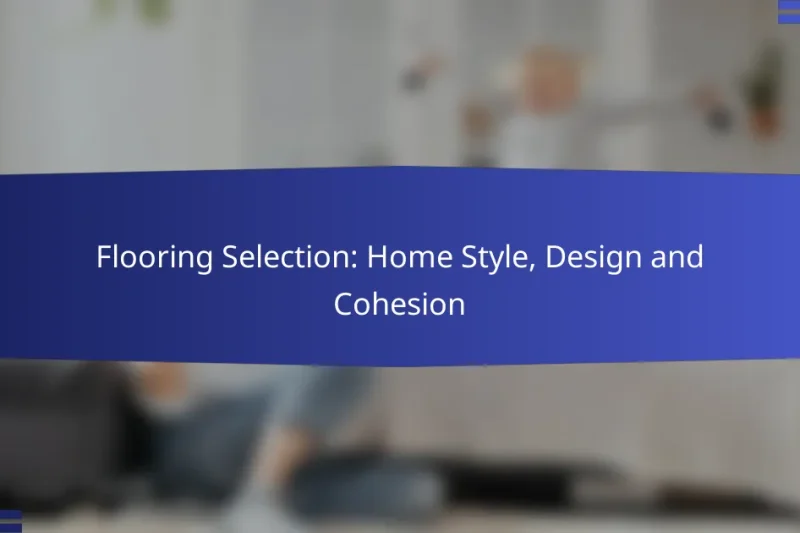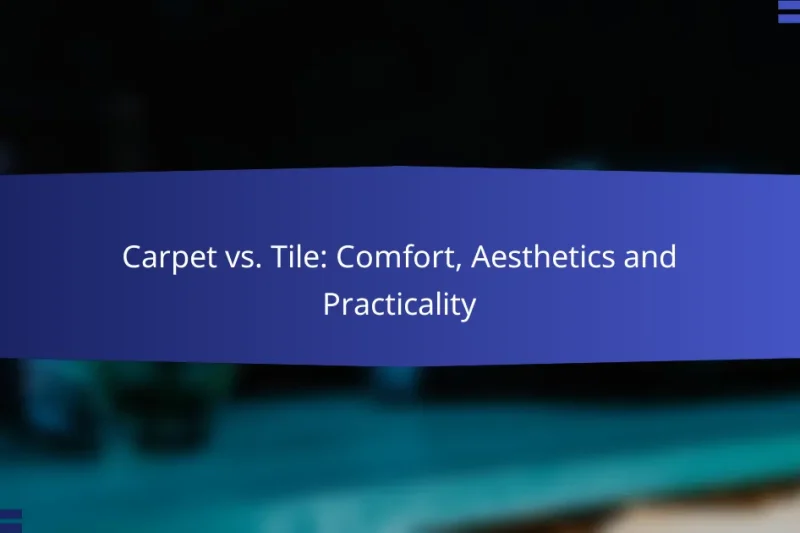When selecting flooring for basements, it’s essential to focus on moisture resistance, durability, and style. Options … Flooring for Basements: Moisture Resistance, Durability and StyleRead more
Flooring Options
When it comes to selecting the perfect flooring for your home, there are a variety of options to consider, including hardwood, laminate, vinyl, tile, and carpet. Each flooring type presents its own set of advantages and challenges, making it crucial to assess your specific needs, budget, and lifestyle to find the ideal fit for your space.
Hardwood vs. Laminate Flooring: Which Is Better and When to Use
When deciding between hardwood and laminate flooring, it’s essential to consider factors like durability, cost, and … Hardwood vs. Laminate Flooring: Which Is Better and When to UseRead more
Eco-Friendly Flooring: Sustainability, Materials and Design
Eco-friendly flooring offers a sustainable alternative to traditional materials, utilizing options like bamboo, cork, and reclaimed … Eco-Friendly Flooring: Sustainability, Materials and DesignRead more
Flooring Selection: Home Style, Design and Cohesion
Selecting the right flooring is essential for enhancing the beauty and functionality of your home. By … Flooring Selection: Home Style, Design and CohesionRead more
Carpet vs. Tile: Comfort, Aesthetics and Practicality
When choosing between carpet and tile for your home, comfort, aesthetics, and practicality play crucial roles … Carpet vs. Tile: Comfort, Aesthetics and PracticalityRead more
What are the best flooring options for homes?
The best flooring options for homes include hardwood, laminate, vinyl, tile, and carpet. Each type offers unique benefits and considerations, making it essential to evaluate your specific needs, budget, and lifestyle before making a choice.
Hardwood flooring
Hardwood flooring is a classic choice known for its durability and aesthetic appeal. It can last for decades with proper care and adds significant value to a home. Consider the type of wood, finish, and installation method when selecting hardwood flooring.
Maintenance involves regular cleaning and occasional refinishing to maintain its shine and longevity. While the initial cost can be high, typically ranging from $5 to $15 per square foot, the investment often pays off in the long run.
Laminate flooring
Laminate flooring mimics the appearance of hardwood or stone at a lower cost, making it a popular choice for budget-conscious homeowners. It consists of a high-density fiberboard core topped with a photographic layer and a protective coating.
Installation is straightforward, often using a click-lock system that allows for easy DIY projects. Prices generally range from $1 to $5 per square foot, but it may not offer the same longevity as hardwood, lasting around 15 to 25 years.
Vinyl flooring
Vinyl flooring is highly versatile and water-resistant, making it suitable for kitchens and bathrooms. Available in sheets, tiles, or planks, vinyl can replicate the look of natural materials without the associated costs.
It is relatively easy to install and maintain, with prices ranging from $1 to $7 per square foot. Look for products with a wear layer for added durability, especially in high-traffic areas.
Tile flooring
Tile flooring is durable and water-resistant, ideal for areas prone to moisture, such as bathrooms and kitchens. Available in ceramic, porcelain, and natural stone, tile offers a wide range of styles and colors.
While installation can be labor-intensive and may require professional help, the longevity of tile flooring can exceed 20 years. Prices typically range from $1 to $20 per square foot, depending on the material and design.
Carpet flooring
Carpet flooring provides warmth and comfort, making it a popular choice for living rooms and bedrooms. Available in various styles, colors, and textures, carpet can enhance the coziness of a space.
However, it requires regular cleaning and maintenance to keep it looking fresh, and it may not be suitable for high-moisture areas. Prices generally range from $2 to $10 per square foot, depending on the quality and type of carpet selected.
How to choose the right flooring for your space?
Choosing the right flooring involves considering the specific needs of your space, including usage, maintenance, and budget. By evaluating these factors, you can select a flooring option that meets your functional and aesthetic requirements.
Consider room usage
The purpose of the room significantly influences the choice of flooring. High-traffic areas like hallways and living rooms may benefit from durable materials such as hardwood or laminate, while moisture-prone spaces like bathrooms and kitchens are better suited for tile or vinyl.
Think about how the room will be used. For example, if you have pets or children, opt for scratch-resistant and easy-to-clean options. Consider comfort as well; softer flooring like carpet can be ideal for bedrooms and playrooms.
Evaluate maintenance requirements
Different flooring types come with varying maintenance needs. Hardwood floors may require periodic refinishing and special cleaning products, while vinyl and tile are generally easier to maintain with simple sweeping and mopping.
Consider how much time and effort you are willing to invest in upkeep. For busy households, low-maintenance options like laminate or luxury vinyl planks can save time and hassle, while still providing a stylish look.
Assess budget constraints
Your budget plays a crucial role in flooring selection. Prices can vary widely; for instance, basic laminate can start at around $1 to $3 per square foot, while high-end hardwood may range from $5 to $15 or more per square foot.
Factor in not just the material cost but also installation expenses. Some flooring types, like carpet, may require professional installation, adding to the overall cost. Always compare options and consider long-term value, including durability and potential resale benefits.
What are the benefits of hardwood flooring?
Hardwood flooring offers numerous advantages, including durability, aesthetic appeal, and increased home value. These benefits make it a popular choice for homeowners looking to enhance their living spaces.
Durability and longevity
Hardwood flooring is known for its exceptional durability and can last for decades with proper care. Unlike other flooring options, hardwood can be sanded and refinished multiple times, allowing it to maintain its appearance over the years.
To ensure longevity, it is essential to maintain humidity levels in your home and avoid excessive moisture, which can warp the wood. Regular cleaning and occasional refinishing can help preserve its quality and extend its lifespan.
Timeless aesthetic appeal
The natural beauty of hardwood flooring adds warmth and elegance to any room, making it a timeless choice for various interior styles. Available in a range of species, colors, and finishes, hardwood can complement both traditional and modern designs.
Choosing the right wood type and finish can significantly impact the overall look of your space. For instance, lighter woods like maple create a bright, airy feel, while darker woods like walnut add richness and sophistication.
Increases home value
Investing in hardwood flooring can enhance your home’s market value, making it more attractive to potential buyers. Many homebuyers prioritize hardwood floors due to their durability and aesthetic appeal, often leading to quicker sales and higher offers.
When considering hardwood flooring, keep in mind that quality installation and maintenance play crucial roles in maximizing your investment. Well-maintained hardwood floors can yield a return on investment of around 70-80% when selling your home.
What are the pros and cons of laminate flooring?
Laminate flooring offers a blend of affordability and aesthetic appeal, making it a popular choice for many homeowners. However, it also has its drawbacks, particularly in terms of durability compared to natural materials like hardwood.
Cost-effective alternative
Laminate flooring is typically more affordable than hardwood, with prices often ranging from $1 to $5 per square foot, depending on quality and design. This makes it an attractive option for those on a budget or looking to renovate without overspending.
Additionally, laminate can mimic the appearance of more expensive materials, allowing homeowners to achieve a high-end look without the associated costs. This cost-effectiveness is particularly appealing for large areas or rental properties.
Easy installation
One of the significant advantages of laminate flooring is its straightforward installation process. Many products feature a click-lock design, allowing for quick assembly without the need for glue or nails.
Homeowners can often install laminate flooring themselves, saving on labor costs. With basic tools and some DIY skills, a typical room can be completed in a single day.
Less durable than hardwood
While laminate flooring is resistant to scratches and stains, it is generally less durable than hardwood. It can be prone to chipping and may not withstand heavy impacts as well as solid wood.
Moreover, laminate is not suitable for areas with high moisture, such as bathrooms or basements, as excessive water can cause it to warp. Homeowners should consider these limitations when choosing laminate for their spaces.
How does vinyl flooring compare to tile flooring?
Vinyl flooring is generally more affordable and easier to install than tile flooring, making it a popular choice for many homeowners. However, tile offers superior durability and water resistance, which can be crucial in certain areas of the home.
Water resistance
When comparing water resistance, tile flooring typically outperforms vinyl. Tile is inherently waterproof, making it ideal for bathrooms, kitchens, and basements where moisture is prevalent.
Vinyl flooring, while water-resistant, can be susceptible to damage if water seeps through seams or edges. It’s essential to choose high-quality vinyl products with a strong wear layer to enhance their water resistance.
For areas prone to spills or high humidity, tile may be the better option. However, if you opt for vinyl, ensure proper installation and maintenance to minimize potential water damage.




